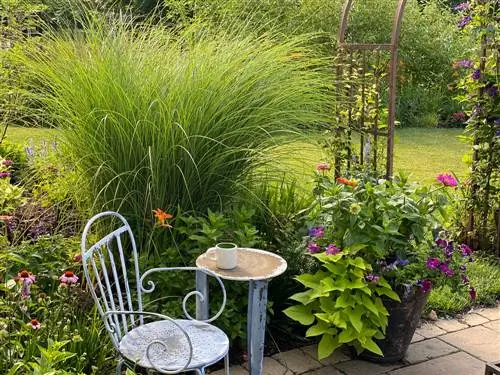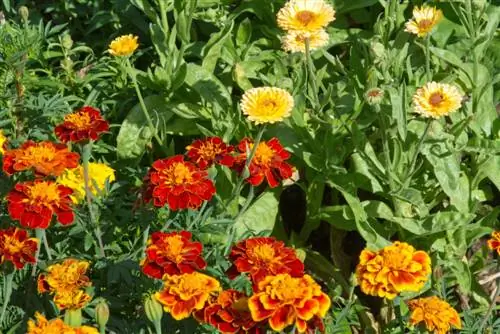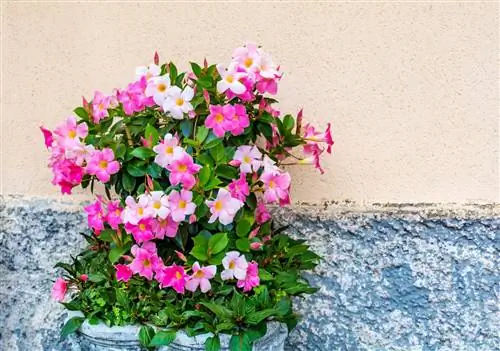- Author admin [email protected].
- Public 2023-12-16 16:46.
- Last modified 2025-01-23 11:22.
It is possibly its delicate and dynamic expression almost all year round that has given miscanthus its good reputation. In particular, its silvery, shiny flowers provide almost magical moments from August onwards. But how do you combine this ornamental grass correctly?
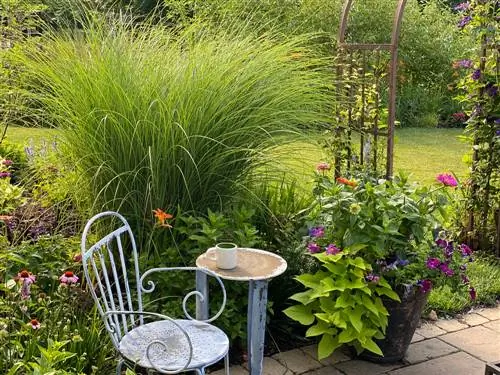
What factors should you consider when combining miscanthus?
In order not to suppress the individuality of miscanthus when combined with other plants and to allow all parties to benefit, you should consider the following factors:
- Foliage color: dark green
- Flower color: silvery white
- Flowering time: August to October
- Location requirements: sunny, permeable and nutrient-rich soil
- Growth height: up to 4 m
The dark green stalks of miscanthus go well with most other plants in the garden. But since miscanthus can grow up to 4 m tall depending on the species, it should be placed in the background when combined with other plants. Otherwise it would cover up its planting partners.
If you want the miscanthus flowers to interact with the flowers of other plants, you should pay attention to the late flowering period.
It is also important to combine miscanthus with plants that have similar requirements for the location. It should therefore not be united with friends of the shadowy existence.
Combine miscanthus in the bed or in the bucket
It is only over the course of the summer that the miscanthus begins to visibly reveal more and more of its dark green stalks. Even in spring it cannot achieve any effect with companion plants. Late-flowering perennials are therefore ideal for combinations. Due to its size, the miscanthus should find its place in the background. Then numerous perennials can achieve a wonderfully graceful and magical expression when interacting with it.
The following, among other things, harmonize with miscanthus:
- Roses
- Autumn Star
- Vervain
- High Stonecrop
- Magnificent candle
- Autumn Anemones
- Yellow Coneflower
Combine miscanthus with autumn anemones
Both the autumn anemones and the miscanthus appear almost floating when they are both in their bloom. The stems of the autumn anemones, gently swaying in the wind, seem to dance with the miscanthus. The two also agree on the location.
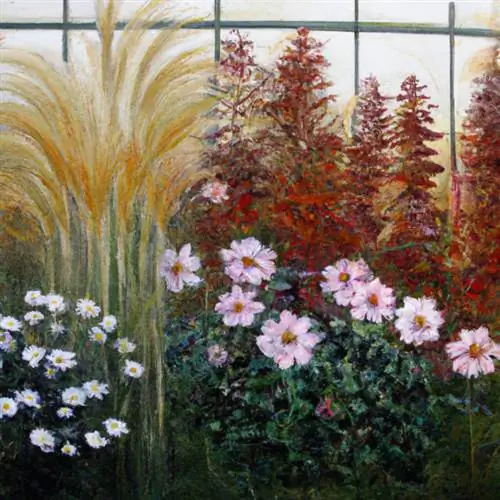
Combine miscanthus with a magnificent candle
The magnificent candle is an ideal companion for the miscanthus, because it looks just as delicate and light as the ornamental grass. Place the two plants in a sunny spot with the candle in front of the miscanthus. White magnificent candles create an image of successful elegance. Pink-red candles, on the other hand, bring a bit of playfulness into the combination with the miscanthus.

Combining miscanthus with roses
The combination of miscanthus and roses, which bloom again in late summer and into autumn, is extremely popular. The symphony of white floribunda roses and Chinese reeds looks extremely elegant. But red, pink, yellow and apricot-colored roses also come into their own with miscanthus as a partner, as the miscanthus gives them a touch of lightness.

Combine Miscanthus as a bouquet in the vase
The flower spikes of miscanthus can enrich all autumnal bouquets. Colorful flowers only become a perfect feast for the eyes when miscanthus is added to the bouquet. Other grasses such as feather grass also go well with the miscanthus in the vase.
- Coneflower
- Autumn Star
- Chrysanthemums
- Roses
- Feather grass

